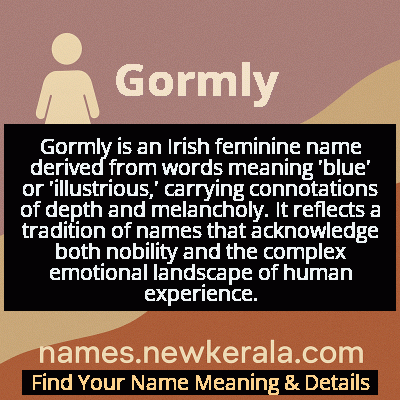Gormly Name Meaning & Details
Origin, Popularity, Numerology Analysis & Name Meaning of Gormly
Discover the origin, meaning, and cultural significance of the name GORMLY. Delve into its historical roots and explore the lasting impact it has had on communities and traditions.
Name
Gormly
Gender
Female
Origin
Irish
Lucky Number
9
Meaning of the Name - Gormly
Gormly is an Irish feminine name derived from words meaning 'blue' or 'illustrious,' carrying connotations of depth and melancholy. It reflects a tradition of names that acknowledge both nobility and the complex emotional landscape of human experience.
Gormly - Complete Numerology Analysis
Your Numerology Number
Based on Pythagorean Numerology System
Ruling Planet
Mars
Positive Nature
Generous, passionate, energetic, and humanitarian.
Negative Traits
Impulsive, impatient, moody, and can be overly emotional.
Lucky Colours
Red, maroon, scarlet.
Lucky Days
Tuesday.
Lucky Stones
Red coral, garnet.
Harmony Numbers
1, 2, 3, 6.
Best Suited Professions
Military, sports, philanthropy, leadership roles.
What People Like About You
Courage, energy, leadership, generosity.
Famous People Named Gormly
Máire Gormly
Poet
Renowned for her melancholic poetry collections exploring Irish identity and loss
Siobhán Gormly
Traditional Musician
Preserved and modernized ancient Irish airs known for their sorrowful tones
Bridget Gormly
Historical Figure
Remembered for her leadership during the Great Famine relief efforts in County Mayo
Eileen Gormly
Activist
Championed women's education in rural Ireland despite personal tragedies
Name Variations & International Equivalents
Click on blue names to explore their detailed meanings. Gray names with will be available soon.
Cultural & Historical Significance
The feminine form Gormly emerged as families sought to preserve clan identity while adapting to changing naming conventions. The name embodies the Irish concept of 'dúchas' - that deep, inherent connection to one's heritage that often carries both pride and sorrow in equal measure. Throughout Irish literary tradition, names with blue connotations often appear in contexts dealing with loss, memory, and the sea - elements deeply woven into Ireland's cultural consciousness. The persistence of this name, despite its melancholic associations, speaks to the Irish appreciation for names that tell complex stories about identity and history.
Extended Personality Analysis
Women named Gormly are often perceived as possessing deep emotional intelligence and a reflective nature. They tend to be introspective individuals who feel emotions intensely, particularly those related to empathy and compassion. This emotional depth frequently manifests as artistic sensitivity or a strong connection to cultural preservation. Their melancholy aspect doesn't indicate depression but rather a profound understanding of life's complexities and a tendency toward philosophical contemplation.
Gormlys typically demonstrate remarkable resilience - their acquaintance with sorrow gives them strength in adversity and makes them exceptional sources of support for others during difficult times. They often possess quiet determination and a strong sense of loyalty to family and tradition, balancing their emotional depth with practical wisdom gained through life experience. While they may appear reserved initially, those who know them well appreciate their dry wit and the surprising humor that often accompanies deep understanding of human nature. Their strength lies in their ability to transform personal and historical sorrow into compassion and meaningful action.
Modern Usage & Popularity
In contemporary times, Gormly remains a rare but meaningful choice, primarily within Irish diaspora communities seeking to honor their heritage. The name has seen a slight resurgence as part of the broader movement toward reviving traditional Irish names, though it maintains its status as an uncommon selection. Modern bearers often appreciate its distinctive sound and deep cultural roots while acknowledging its melancholic connotations. The name appears more frequently as a middle name than a first name in recent decades, serving as a subtle nod to ancestry without the weight of daily use. Its usage patterns reflect a balance between preserving cultural identity and adapting to modern naming sensibilities, with most contemporary Gormlys being found in Ireland, the United Kingdom, North America, and Australia among families with strong Irish connections.
Symbolic & Spiritual Meanings
Symbolically, Gormly represents the beautiful tension between sorrow and strength that characterizes much of Irish cultural expression. The 'blue' element connects to both the vastness of the ocean and the depth of human emotion, suggesting boundless capacity for feeling and understanding. It embodies the Celtic tradition of finding beauty in melancholy and wisdom in hardship. The name symbolizes the resilience of Irish womanhood - the ability to carry historical memory while moving forward with grace. Like the Irish landscape itself, which can appear both bleak and breathtakingly beautiful, Gormly represents the capacity to hold contrasting emotions simultaneously, finding meaning in the spaces between joy and sorrow. It serves as a reminder that depth of feeling, even when tinged with sadness, can be a source of profound strength and connection to others.

